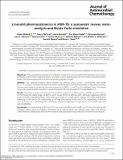Files in this item
Linezolid pharmacokinetics in MDR-TB : a systematic review, meta-analysis and Monte Carlo simulation
Item metadata
| dc.contributor.author | Millard, James | |
| dc.contributor.author | Pertinez, Henry | |
| dc.contributor.author | Bonnett, Laura | |
| dc.contributor.author | Model, Eva Maria | |
| dc.contributor.author | Dartois, Véronique | |
| dc.contributor.author | Johnson, John L | |
| dc.contributor.author | Caws, Maxine | |
| dc.contributor.author | Tiberi, Simon | |
| dc.contributor.author | Bolhuis, Mathieu | |
| dc.contributor.author | Alffenaar, Jan-Willem C | |
| dc.contributor.author | Davies, Geraint | |
| dc.contributor.author | Sloan, Derek James | |
| dc.date.accessioned | 2018-03-27T12:30:05Z | |
| dc.date.available | 2018-03-27T12:30:05Z | |
| dc.date.issued | 2018-03-23 | |
| dc.identifier | 252481286 | |
| dc.identifier | 8ec0e68a-1e69-4337-8126-ea7cf22b0ec6 | |
| dc.identifier | 85050237374 | |
| dc.identifier | 000438375800003 | |
| dc.identifier.citation | Millard , J , Pertinez , H , Bonnett , L , Model , E M , Dartois , V , Johnson , J L , Caws , M , Tiberi , S , Bolhuis , M , Alffenaar , J-W C , Davies , G & Sloan , D J 2018 , ' Linezolid pharmacokinetics in MDR-TB : a systematic review, meta-analysis and Monte Carlo simulation ' , Journal of Antimicrobial Chemotherapy , vol. 73 , no. 7 , pp. 1755-1762 . https://doi.org/10.1093/jac/dky096 | en |
| dc.identifier.issn | 0305-7453 | |
| dc.identifier.other | ORCID: /0000-0002-7888-5449/work/60631026 | |
| dc.identifier.uri | https://hdl.handle.net/10023/13028 | |
| dc.description | This work was supported by the Wellcome Trust (grant numbers 109129/Z/15/Z to JM and 105620/Z/14/Z to DS and MC). | en |
| dc.description.abstract | Objectives The oxazolidinone linezolid is an effective component of drug - resistant TB treatment, but use is limited by toxicity and the optimum dose is uncertain . Current strategies are not informed by clinical pharmacokinetic/pharmacodynamic (PK/PD) data, we aimed to aimed to address this gap. Methods We defined linezolid PK/PD targets for efficacy; free area under the time - concentration curve: minimum inhibitory concentration ratio (ƒAUC0-24:M IC) >119m g/L/hr and safety; free minimum concentration (Cmin) <1.38mg/L . We extracted individual - level linezolid PK data from existing studies on TB patients and performed meta - analysis; producing summary estimates of ƒAUC0-24 and ƒCmin for published doses . Combining these with a published MIC distribution, we performed Monte Carlo simulations of target attainment. Results The efficacy target was attained in all simulated individuals at 300mg q12h and 600mg q12h , but only 20.7% missed the safety target at 300mg q12h versus 98.5% at 600mg q12h . Although suggesting 300mg q12h should be used preferentially, these data were reliant on a single centre . Efficacy and safety targets were missed by 41.0% and 24.2% respectively at 300mg q24h , and 44.5% and 27.5% at 600mg q24h . However, the confounding effect of between study heterogeneity on target attainment for q24h regimens was considerable. Conclusions 300mg q12h linezolid dosing may retain the efficacy of the 600mg q12h licensed dosing with improved safety. Data to evaluate commonly used 300mg q24h and 600mg q24h doses is limited. Comprehensive, prospectively obtained PK/PD data for linezolid doses in drug - resistant TB treatment are required. | |
| dc.format.extent | 8 | |
| dc.format.extent | 820023 | |
| dc.language.iso | eng | |
| dc.relation.ispartof | Journal of Antimicrobial Chemotherapy | en |
| dc.subject | QR Microbiology | en |
| dc.subject | RM Therapeutics. Pharmacology | en |
| dc.subject | NDAS | en |
| dc.subject.lcc | QR | en |
| dc.subject.lcc | RM | en |
| dc.title | Linezolid pharmacokinetics in MDR-TB : a systematic review, meta-analysis and Monte Carlo simulation | en |
| dc.type | Journal article | en |
| dc.contributor.institution | University of St Andrews. School of Medicine | en |
| dc.contributor.institution | University of St Andrews. Infection and Global Health Division | en |
| dc.identifier.doi | 10.1093/jac/dky096 | |
| dc.description.status | Peer reviewed | en |
This item appears in the following Collection(s)
Items in the St Andrews Research Repository are protected by copyright, with all rights reserved, unless otherwise indicated.

